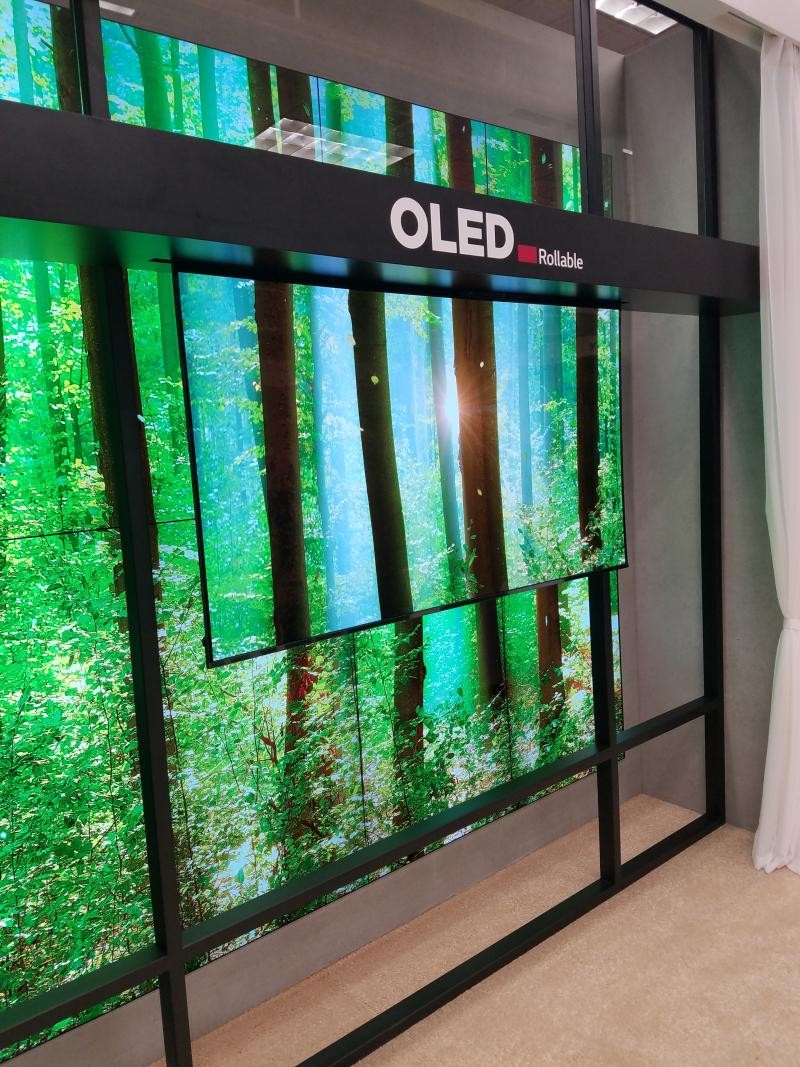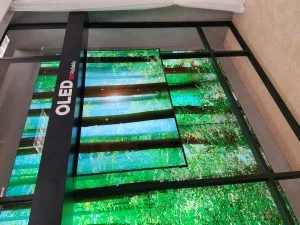Bob Raikes has been written several Display Dailies on what he saw at CES. Now it’s my turn. The following are not the big stories that everybody has written about, but they are things that caught my fancy.

1. Sharp Abandons North American TV Business.
At CES 2019 Sharp announced its return to the North American premium TV market, and attempted to distinguish itself with an 8K-only model line-up. The company had a large booth at CES 2020, so it was a shock when the analysts’ telegraph began humming with news that Sharp had pulled the plug on its high-end North American TV ambitions. The word is that when Sharp seriously started looking for large customers (presumably at CES), those customers said there was no shortage of 8K sets from the likes of Samsung, LG, and the major Chinese companies, and that they didn’t need another supplier. When I offered my condolences to Sharp SVP of Sales and Marketing Peter Weedfald, he seemed surprised I knew but didn’t correct me.
2. Lenovo Shows Two-Display Notebook PC
Lenovo unveiled its ThinkBook Plus, a ruggedized $1200 notebook that will be introduced in March. The PC seems conventional when you look at the 13.3-inch, FHD IPS LCD main display from across the keyboard. (This display supports Dolby Vision.) What’s different is that there is an 10.8-inch E Ink writing surface on the cover (Fig. 1).
The user can create notes, illustrations, and diagrams on the writing surface with an integrated pen, and utlize “Modern Standby” to receive emails and notifications even when the lid is closed. Notes written on the writing surface can be synced with Microsoft OneNote, and the integrated Amazon Alexa for PC allows you to “quickly execute a number of common tasks, without the need to open your laptop.” Lenovo also allows you “personalize your laptop with a unique screensaver on the laptop cover.”
 1. Lenovo’s ThinkBook Plus has an E Ink writing surface on the outer surface of its cover. (Photo: Lenovo)
1. Lenovo’s ThinkBook Plus has an E Ink writing surface on the outer surface of its cover. (Photo: Lenovo)
3. TV Makers Create Sets Designed for Gaming
Gaming monitors, which support variable refresh rate via Nvidia’s G-Sync or AMD’s FreeSync, have been around for several years. These systems match the monitor’s refresh rate to the game’s frame rate as delivered by the graphics card, which minimizes screen tearing, stuttering, and input lag — important if you’re trying to de-pixelize an angry beetle from the planet Munch.
At CES, makers such as Samsung and TCL had integrated this technology into gaming TV sets. In cooperation with TCL, THX introduced Certified Game Mode, which which will make it easy for users to optimize contrast and color for game media. Variable refresh is not part of the certification, but game mode does disable features intended to enhance the display of movies and TV shows, but does so at the expense of increased input lag. TCL will introduce sets with Certified Game Mode this year, but other makers can work with THX to incorporate the mode.
4. LGD
Among the many new products and technology demos LG Display showed at its limited-access suite in North Hall was a 48-inch OLED panel for lower-cost OLED TVs. LGD also stood the rollable OLED-R TV screen on its head (Fig. 2). Instead of having the screen roll up from a cabinet on the floor, this version rolls down. In the CES demo, the OLED-R rolled down from the top of an architecural window frame rather than from a wall- or ceiling-mounting cabinet.
 2. LG Display showed a version of its OLED-R rollable display that rolls down from a window frame instead of rolling up from a floor-mounted cabinet. (Photo: Ken Werner)
2. LG Display showed a version of its OLED-R rollable display that rolls down from a window frame instead of rolling up from a floor-mounted cabinet. (Photo: Ken Werner)
5. Filmmaker Mode
At its press conference LG promoted the Filmmaker Mode™ developed by the UHD Alliance last year, and said it will include the mode in every new 4K and 8K set it introduces in 2020. This idea pops up from time to time, always failing to make much impact outside of purist circles, said Pete Putman, President of ROAM Consulting and columnist for Sound and Communications Magazine. But film directors love it.
The UHD Alliance calls it the “next-level home theater viewing experience” and describes it this way: “By disabling all post-processing (e.g. motion smoothing, etc.) and preserving the correct aspect ratios, colors and frame rates, Filmmaker Mode enables your TV to display the movie or television show’s content precisely as it was intended by the filmmaker.” Of course, any viewer willing and able to dig into the menu system of his or her TV can disable the post-processing features individually, but Filmmaker Mode does it all with one virtual button (or might even turn itself on automatically when triggered by appropriate media). In addition to LG, the feature is supported by Panasonic (which does not sell TVs in North Amnerica), Vizio, Samsung, and TP Vision (which makes Philips-branded TVs).
I have more of these, which I will happily share with you in a forthcoming Display Daily. (KW)
Ken Werner is Principal of Nutmeg Consultants, specializing in the display industry, manufacturing, technology, and applications, including mobile devices, automotive, and television. He consults for attorneys, investment analysts, and companies re-positioning themselves within the display industry or using displays in their products. He is the 2017 recipient of the Society for Information Display’s Lewis and Beatrice Winner Award. You can reach him at [email protected] or www.nutmegconsultants.com.

